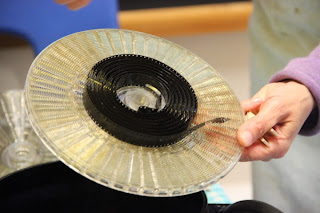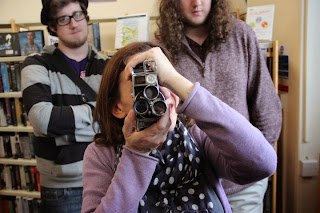Friday, 24 April 2015
Wednesday, 22 April 2015
Thursday, 16 April 2015
Audience Feedback
Once I had completed my practical work, I decided to put it back to my target audience to see what their feedback was of the film.
This survey was about getting what they audience thought after watching the final film and seeing the two print accompaniments. The reception was very good, and nobody said they didn't like the products. As per the Blumler and Kats Uses and Gratification Theory (1974), the audience would use my film for escapism, entertainment, socialisation, and information, and the feedback shows that we have effectively responded to the audience's wants with our film. The main improvement suggested was the building of suspense, and this was definitely difficult to try and achieve whilst making the film, so this is a fair comment and I will endeavour to improve my ability to create tension through film in future films that I make. I will not have been able to make a short film that the audience want to watch without the level of audience research I did throughout the project, so this research has been invaluable in helping me make this film.
Friday, 10 April 2015
The Editing Process
As we had quite a few locations, for just a five minute short, and they were filmed at different times, I decided it was easier to edit each scene on its own Premiere Pro document to make it easier to edit the whole film together in the end. I used Premiere Pro because having access to it is great due to it being a state of the art piece of software, and therefore learning to use it is a great way of learning skills early on to progress in my further education of film.
The first scene we filmed and therefore edited was the cafe scene. This had a nice range of shots following Franklin and Sam walking down to the cafe which was really fun to put together. It also didn't involve a lot of overlaying sound or transitions at this point.
Secondly, the pond scene was edited as we filmed this on the same day as the cafe scene, and this was a very simple scene to edit, being just a short transition scene, showing use location and to help the narrative. The editing consisted of just placing the four different shots together and not really much other editing.
Our third shoot was on location at Bodmin Jail and thus we filmed all of the footage needed of this location at the same time due to it costing money for usage. In this, we filmed both scenes 5 and 6, and then edited each in a separate document, like before. This was a bit more difficult, due to the jumps cuts used in scene 5 with Anonymous appearing and disappearing which took a lot of editing to get this effect right. Scene 6 has lots of different sounds added on and overlayed footage which meant that editing this took a few more channels than the previous scenes.
The final scene in the film wasn't the last one we filmed, but it was after the jail scene because we needed the photographs from that shoot to construct the set for this scene. Editing this was probably the most difficult scene yet because the extreme close ups of Franklin's face when he says "I hear voices" was created to be a sort of dazed, dreamlike sequence which involved the repetition of sound and the layering of footage. I used dissolve transitions here to make this sequence look more confusing and visually interesting.
The car scene was simple to edit as there were only two shots to use, and this would be edited further in the final edit as it will be mostly used as a voice over.
The final edit was a lot more difficult to edit because the combining of all of the scenes, with the addition of transitional shots, for example the establishing of the jail and the police station, as well as the addition of some sound effects, the score, the title, and the brand logo. I also had to edit the clips to cut out parts to make sure the time of the film was correct, as well as editing the colour of the final scene to ensure it looked like a conventional police interrogation scene, and finally I added in dissolves to make the shots flow into each other and the change in location smooth and not entirely straight cuts.
I created the brand logo and film title animations on AfterEffects - another state of the art Adobe program that would really enhance my skills upon knowing the basics, and this was predominantly an exploration through the effects that are available on the software that could make my fairly mundane logo and title look a lot more professional and interesting within the film. For the title I used the shatter effect to make the explosion of pieces, and I edited the settings to increase the number of pieces the words shattered into. for my brand logo I experimented with the entrance transitions, so that I could find the visually interesting way for each of the four components of the logo to enter the screen. In the end, I used effects including 3D Tumble, 2D Tumble, Slide and Stretch, and Spin.
Monday, 6 April 2015
8mm Film Workshop
With film being one of my main interests, an extra-curricular project that I really wanted to get involved in was Loop The Loop: exploring my local heritage through film. The workshop I attended at Loop The Loop was about hand-processing 8mm film using household items, including: instant coffee, vitamin C, washing powder, and salt. This alone I found fascinating, but the experience also allowed us to use the specialised equipment, such as film processing tanks and spirals.
Following our enthusiasm, Joanna Mayes, artist and filmmaker, decided to take our workshop further than planned and teach us how to use an 8mm camera in order to create our own film that day. This involved using an iPhone app to detect light levels and give us accurate information on the f-stop and aperture we should be using in order to make our film look the best it can be, and then we just filmed as many different things as possible; we focused a lot on motion and how it would look on film.
At the end of the day, Jo asked us to come along again the next day so that we could hand-process our own film, and this was a really good end to the workshop as it allowed us to showcase what we had learnt by going through the process ourselves, with supervision by Jo, and process and dry our own work. Whilst doing this, we explained the process to other attendees of the project, and fully cemented what we had learnt.
Overall, the project, I felt, was incredibly interesting, and learning how filmmaking used to be done before everything went digital has inspired me to join the extensive community of people still using old-fashioned film by starting to do this myself in the future. The project as a whole made it into the Cornish Guardian newspaper, and the article featured myself, Joanne Mayes, and Joseph Crowe-Delderfield, a fellow student that attended the workshop.
Following our enthusiasm, Joanna Mayes, artist and filmmaker, decided to take our workshop further than planned and teach us how to use an 8mm camera in order to create our own film that day. This involved using an iPhone app to detect light levels and give us accurate information on the f-stop and aperture we should be using in order to make our film look the best it can be, and then we just filmed as many different things as possible; we focused a lot on motion and how it would look on film.
At the end of the day, Jo asked us to come along again the next day so that we could hand-process our own film, and this was a really good end to the workshop as it allowed us to showcase what we had learnt by going through the process ourselves, with supervision by Jo, and process and dry our own work. Whilst doing this, we explained the process to other attendees of the project, and fully cemented what we had learnt.
Overall, the project, I felt, was incredibly interesting, and learning how filmmaking used to be done before everything went digital has inspired me to join the extensive community of people still using old-fashioned film by starting to do this myself in the future. The project as a whole made it into the Cornish Guardian newspaper, and the article featured myself, Joanne Mayes, and Joseph Crowe-Delderfield, a fellow student that attended the workshop.
Subscribe to:
Comments (Atom)



























